Distributed Generation and Renewable Energy Integration into the Grid: Prerequisites, Push Factors, Practical Options, Issues and Merits
Abstract
1. Introduction
Objectives and Methodology
2. The Concept of Distributed Generation (DG)
2.1. Considerations of the Classification of DGs
2.2. Push Factors in the Increasing Addition of DG in the Power System
2.2.1. Environmentally Motivated Factors
2.2.2. Economic Factors
2.2.3. National/Regulatory Factors
2.3. Grid Expansion through Distributed Renewables
2.4. Location and Capacity of DG on a Power Network
3. Some Practical Options Used in DG to Grid Integration
3.1. Vigorous Voltage Regulation at the Level of Substations
3.2. Modified Grid Configuration
3.3. The Use of the ‘N Minus Zero’ Regulation
3.4. Reactive Power Control
3.5. Creation of Express Feeders in the MV Network
4. Issues Resulting from DG to Grid Integration
4.1. Voltage Level Fluctuations
4.2. Effects on Power Line Losses
4.3. Variability of Wind and Solar Resources
4.4. Issues from an Economic Perspective
4.5. Transient Voltage Changes
4.6. Voltage Flickers
- is the wind farm flicker coefficient obtained through a series of wind turbine tests;
- is the network impedance phase angle;
- is the annual average wind speed;
- is the wind farm rated power;
- is the short-circuit power at the point of common coupling (PCC)
4.7. Harmonics Distortion
4.8. Grid Instability
4.9. Increase in the Fault Level and Fragile Protection System
5. Review on Case Studies
5.1. Case of South of England
5.2. Case of Greece
5.3. Case of Portugal
5.4. Case of Pakistan
5.5. Case of Maryland, USA
5.6. Case Studies of DG Being Used to Resolve Grid Turbulence
5.7. Review on Ideal Test Grid
5.8. Lessons from Successful Countries Integrating Distributed Energy Sources
5.8.1. Case of Italy
5.8.2. Case of Germany
5.8.3. Case of China
6. Merits of DG Integration into the Grid
6.1. Peak Demand Curtailment
6.2. Reduction of Power Losses in the Network
6.3. Frequency Regulation
6.4. Voltage Stabilization
6.5. Less Risk of Terrorism
6.6. Shelving of Network Upgrade
6.7. Improved Reliability and Security of Supply in the Network
6.8. Delivery of Ancillary Services
6.9. Economic Viability of DG Projects
7. Discussion and Future Perspectives
8. Conclusions
Author Contributions
Funding
Institutional Review Board Statement
Informed Consent Statement
Acknowledgments
Conflicts of Interest
References
- Carley, S. Distributed generation: An empirical analysis of primary motivators. Energy Policy 2009, 37, 1648–1659. [Google Scholar] [CrossRef]
- Allan, G.; Eromenko, I.; Gilmartin, M.; Kockar, I.; McGregor, P. The economics of distributed energy generation: A literature review. Renew. Sustain. Energy Rev. 2015, 42, 543–556. [Google Scholar] [CrossRef]
- Renewable Energy Policy Network for the 21st Century (REN21). Renewables—Global Status Report; REN21 Secretariat: Paris, France, 2017. [Google Scholar]
- International Renewable Energy Agency (IRENA). Report on Renewable Energy Capacity Statistics; (IRENA): Abu Dhabi, UAE, 2017. [Google Scholar]
- Wasiak, I.; Hanzelka, Z. Integration of distributed energy sources with electrical power grid. Bull. Pol. Acad. Sci. Tech. Sci. 2009, 57, 297–308. [Google Scholar] [CrossRef]
- Luhmann, T.; Wieben, T.E.; Treydel, R.; Stadler, M.; Kumm, T. An approach for cost-efficient grid integration of distributed renewable energy sources. Eng. Sci. Press 2015, 1, 447–452. [Google Scholar] [CrossRef][Green Version]
- Kempener, R.; Komor, P.; Hoke, A. Smart Grids and Renewables—A Guide for Effective Deployment; International Renewable Energy Agency (IRENA): Abu Dhabi, UAE, 2013. [Google Scholar]
- Muntathir, A.T.; Chokri, A.B. Optimal PV penetration for power losses subject to transient stability and harmonics. Proc. Comput. Sci. 2020, 175, 508–516. [Google Scholar]
- Zahedi, A. A review of drivers, benefits, and challenges in integrating renewable energy sources into electricity grid. Renew. Sustain. Energy Rev. 2011, 15, 4775–4779. [Google Scholar] [CrossRef]
- Soroudi, A.; Ehsan, M.; Caire, R.; Hadjsaid, N. Possibilistic evaluation of distributed generations impacts on distribution networks. IEEE Trans. Power Syst. 2011, 26, 2293–2301. [Google Scholar] [CrossRef]
- Lopes, V.S.; Borges, C.L.T. Impact of the combined integration of wind generation and small hydropower plants on the system reliability. IEEE Trans. Sustain. Energy 2015, 6, 1169–1177. [Google Scholar] [CrossRef]
- Adil, A.M.; Ko, Y. Socio-technical evolution of decentralized energy systems: A critical review and implications for urban planning and policy. Renew. Sustain. Energy Rev. 2016, 57, 1025–1037. [Google Scholar] [CrossRef]
- Colmenar, S.A.; Reino, R.C.; Borge, D.D.; Collado, F.E. Distributed generation: A review of factors that can contribute most to achieve a scenario of DG units embedded in the new distribution networks. Renew. Sustain. Energy Rev. 2016, 59, 1130–1148. [Google Scholar] [CrossRef]
- CIGRE Study Committee. Impact of Increasing Contribution of Dispersed Generation on the Power System; International Council on Large Electricity Systems (CIGRE): Paris, France, 1998. [Google Scholar]
- Ajit, K.; Selvan, M.P.; Rajapandiyan, K. Grid Stability Analysis for High Penetration Solar Photovoltaics. NIT Trichy: Thuvakudi, India, 2016. [Google Scholar]
- Archana, R.; Subramaniya, S.A. A perspective analysis for the impact of PV and wind hybrid distributed generation using eTAP. Int. J. Adv. Res. Electr. Electron. Instrum. Eng. 2018, 7, 2023–2029. [Google Scholar]
- Bank, J.; Mather, B.; Keller, J.; Coddington, M. High Penetration Photovoltaic Case Study Report; Technical Report; National Renewable Energy Laboratory: Denver, CO, USA, 2013.
- Belcher, B.; Petry, B.J.; Davis, T.; Hatipoglu, K. The effects of major solar integration on a 21-Bus system: Technology review and PSAT simulations. In Proceedings of the SoutheastCon 2017, Concord, NC, USA, 30 March–2 April 2017. [Google Scholar]
- Chiradeja, P.; Ramakumar, R. An approach to quantify the technical benefits of distributed generation. IEEE Trans. Energy Convers. 2004, 19, 764–773. [Google Scholar] [CrossRef]
- Ochoa, L.F.; Padilha-Feltrin, A.; Harrison, G.P. Evaluating distributed generation impacts with a multiobjective index. IEEE Trans. Power Deliv. 2006, 21, 1452–1458. [Google Scholar] [CrossRef]
- Singh, D.; Singh, D.; Verma, K.S. Multiobjective optimization for DG planning with load models. IEEE Trans. Power Syst. 2009, 24, 427–436. [Google Scholar] [CrossRef]
- Pepermans, G.; Driesen, J.; Haeseldonckx, D.; Belmans, R.; D’haeseleer, W. Distributed generation: Definition, benefits and issues. Energy Policy 2005, 33, 787–798. [Google Scholar] [CrossRef]
- International Energy Agency. Energy Technologies for the 21st Century; IEA: Paris, France, 1997. [Google Scholar]
- Ackermann, T.; Anderson, G.; Söder, L. Distributed generation: A definition. Elect. Power Sys. Res. 2001, 57, 195–204. [Google Scholar] [CrossRef]
- Dondi, P.; Bayoumi, D.; Haederli, C.; Julian, D.; Suter, M. Network integration of distributed power generation. J. Power Sources 2002, 106, 1–9. [Google Scholar] [CrossRef]
- Chambers, A. Distributed Generation: A Non-Technical Guide; Pennwell: Tulsa, OK, USA, 2001. [Google Scholar]
- Willis, H.L.; Scott, W.G. Distributed Power Generation; Marcel Dekker: New York, NY, USA, 2000. [Google Scholar]
- Khetrapal, P. Distributed generation: A critical review of technologies, grid integration issues, growth drivers and potential benefits. Inter. J. Renew. Energy Dev. 2020, 9, 189–205. [Google Scholar] [CrossRef]
- Paliwal, P.; Patidar, N.P.; Nema, R.K. Planning of grid integrated generators: A review of technology, objectives and planning. Renew. Sustain. Energy Rev. 2014, 40, 4557–4570. [Google Scholar] [CrossRef]
- Renewable Energy Policy Network for the 21st Century (REN21). Renewables 2019 Global Status Report; REN21 Secretariat: Paris, France, 2019. [Google Scholar]
- Renewable Energy Policy Network for the 21st Century (REN21). Renewables 2020 Global Status Report; REN21 Secretariat: Paris, France, 2020. [Google Scholar]
- Jain, S.; Kalambe, S.; Agnihotri, G.; Mishra, A. Distributed generation deployment: State-of-the-art of the distribution system planning in sustainable era. Renew. Sustain. Energy Rev. 2017, 77, 363–385. [Google Scholar] [CrossRef]
- Van-Thong, V.; Driesen, J.; Belmans, R. Power quality and voltage stability of distribution system with distributed energy resources. Inter. J. Distrib. Energy Res. 2005, 1, 227–240. [Google Scholar]
- Singh, D.; Misra, R.K.; Singh, D. Effect of load models in distributed generation planning. IEEE Trans. Power Sys. 2007, 22, 2204–2212. [Google Scholar] [CrossRef]
- Iyer, H.; Ray, S.; Ramakumar, R. Voltage profile improvement with distributed generation. IEEE Power Eng. Soc. Gen. Meet. 2005, 3, 1603–1610. [Google Scholar]
- Nabavi, S.M.H.; Hajforoosh, S.; Masoum, M.A.S. Placement and sizing of distributed generation units for congestion management and improvement of voltageprofile using particle swarm optimization. IEEE PES Innov. Smart Grid Technol. 2011, 1–6. [Google Scholar] [CrossRef]
- Bayer, B.; Marian, A. Innovative measures for integrating renewable energy in the German medium-voltage grids. Energy Rep. 2020, 6, 336–342. [Google Scholar] [CrossRef]
- Markiewicz, H.; Klajn, A. Voltage Disturbances: Standard EN 50160 Voltage Characteristics in Public Distribution Systems; European Copper Institute: Brussels, Belgium, 2011. [Google Scholar]
- Forum Grid Technology of the VDE. Voltage-Regulated Distribution Transformer (VRDT)—Use in Grid Planning and Operation; Forum Netztechnik/Netzbetrieb im VDE (FNN): Berlin, Germany, 2016. [Google Scholar]
- Roy, N.; Pota, H.R. Current status and issues of concern for the integration of distributed generation into electricity networks. IEEE Sys. J. 2015, 9, 933–944. [Google Scholar] [CrossRef]
- Bayer, B.; Matschoss, P.; Thomas, H.; Marian, A. The German experience with integrating photovoltaic systems into the low-voltage grids. Renew. Energy 2018, 119, 129–141. [Google Scholar] [CrossRef]
- Wang, Q.; Zhang, C.; Ding, Y.; Xydis, G.; Wang, J.; Østergaard, J. Review of real time electricity markets for integrating Distributed Energy Resources and Demand Response. Appl. Energy 2015, 138, 695–706. [Google Scholar] [CrossRef]
- Conti, S.; Raiti, S.; Tina, G. Small scale generation effect on embedded on voltage profile: Am analytical Method. IEEE Proc. Gener. Transm. Distrib. 2003. [Google Scholar] [CrossRef]
- Mahmud, M.A.; Hossain, M.J.; Pota, H.R. Voltage variation on distribution networks with distributed generation: Worst case scenario. IEEE Sys. J. 2014, 8, 1096–1103. [Google Scholar] [CrossRef]
- Mahmud, N.; Zahedi, A. Review of control strategies for voltage regulation of the smart distribution network with high penetration of renewable distributed generation. Renew. Sustain. Energy Rev. 2016, 64, 582–595. [Google Scholar] [CrossRef]
- Khalesi, N.; Rezaei, N.; Haghifam, M.R. DG allocation with application of dynamic programming for loss reduction and reliability improvement. Int. J. Electr. Power Energy Syst. 2011, 33, 88–295. [Google Scholar] [CrossRef]
- Delfanti, M.; Falabretti, D.; Merlo, M. Dispersed generation impact on distribution network losses. Electr. Power Syst. Res. 2013, 97, 10–18. [Google Scholar] [CrossRef]
- Zaheeruddin, M.M. Renewable energy management through microgrid central controller design: An approach to integrate solar, wind and biomass with battery. Energy Rep. 2015, 1, 156–163. [Google Scholar] [CrossRef]
- Agah, M.S.M.; Abyaneh, H.A. Distribution transformer loss-of-life reduction by increasing penetration of distributed generation. IEEE Trans. Power Deliv. 2011, 26, 1128–1136. [Google Scholar] [CrossRef]
- Agah, M.S.M.; Abyaneh, H.A. Quantification of the distribution transformer life extension value of distributed generation. IEEE Trans. Power Deliv. 2011, 26, 1820–1828. [Google Scholar] [CrossRef]
- El-Batawy, S.A.; Morsi, W.G. On the Impact of high penetration of rooftop solar photovoltaics on the aging of distribution transformers. Can. J. Electr. Comput. Eng. 2017, 40, 93–99. [Google Scholar]
- Csányi, G.M.; Tamus, Z.Á.; Varga, Á. Impact of distributed generation on the thermal ageing of low voltage distribution cables. In Technological Innovation for Smart Systems; IFIP Advances in Information and Communication Technology 2017; Springer: New York, NY, USA, 2017; pp. 251–258. [Google Scholar]
- British Standards Institution (BSI). BS EN61400-21 Wind Turbines: Measurement and Assessment of Power Quality Characteristics of Grid Connected Wind Turbines; BSI: London, UK, 2009.
- Latran, M.B.; Teke, A.; Yoldas, Y. Mitigation of power quality problems using distribution static synchronous compensator: A comprehensive review. IET Power Electron. 2015, 8, 1312–1328. [Google Scholar] [CrossRef]
- Bizon, N. Effective mitigation of the load pulses by controlling the battery/SMES hybrid energy storage system. Appl. Energy 2018, 229, 459–473. [Google Scholar] [CrossRef]
- Brearley, J.B.; Raja, P.R. A review on issues and approaches for microgrid protection. Renew. Sustain. Energy Rev. 2017, 67, 988–997. [Google Scholar] [CrossRef]
- Ishchenko, D.; Oudalov, A.; Stoupis, J. Protection coordination in active distribution grids with IEC 61850. In Proceedings of the IEEE PES Transmission and Distribution Conference and Exposition (T&D), Orlando, FL, USA, 7–10 May 2012. [Google Scholar]
- Murugan, R.; Ramasamy, R. Failure analysis of power transformer for effective maintenance in electric machines. Eng. Fail. Anal. 2015, 55, 182–192. [Google Scholar] [CrossRef]
- Trichakis, P.; Taylor, P.; Lyons, P.; Hair, R. Predicting the technical impact of high levels of small embedded generators on low voltage networks. Renew. Power Gener. 2008, 2, 249–262. [Google Scholar] [CrossRef]
- Scottish and Southampton Power Distribution. Generation Availability Map. 2016. Available online: https://ssepd.co.uk/GenerationAvailabilityMap/?mapareaid=1 (accessed on 13 April 2021).
- Western Power Distribution. Distributed Generation ehv Constraint Map. 2018. Available online: https://www.westernpower.co.uk/connections/generation/distributed-generation-ehv-constraint-maps.aspx (accessed on 25 March 2021).
- Pinto, R.J.C.; Mariano, S.J.P.S.; Maria, R.A.C. Power quality experimental analysis on rural home grid-connected PV systems. Int. J. Photoenergy 2015, 2015, 791680. [Google Scholar] [CrossRef]
- European Standard EN 50160 (CENELEC). Voltage Characteristics of Electricity Supplied by Public Distribution Networks; CENELEC: Brussels, Belgium, 2007. [Google Scholar]
- Mujtaba, G.; Rashid, Z.; Umer, F.; Baloch, S.K.; Hussain, G.A.; Haider, M.U. Implementation of distributed generation with solar plants in a 132 kV grid station at layyah using ETAP. Int. J. Photoenergy 2020, 2020, 6574659. [Google Scholar] [CrossRef]
- Liu, E.; Bebic, J. Distribution System Voltage Performance Analysis for High-Penetration Photovoltaics; OSTI: New York, NY, USA, 2008.
- Majumder, R. Reactive power compensation in single-phase operation of microgrid. IEEE Trans. Ind. Electr. 2013, 60, 1403–1416. [Google Scholar] [CrossRef]
- Pathak, A.K.; Sharma, M.P.; Gupta, M. Modeling and simulation of SVC for reactive power control in high penetration wind power system. In Proceedings of the Annual IEEE India Conference (INDICON), New Delhi, India, 17–20 December 2015. [Google Scholar]
- Miranda, I.; Silva, N.; Leite, H. A holistic approach to the integration of battery energy storage systems in island electric grids with high wind penetration. IEEE Trans. Sustain. Energy 2016, 7, 20775–207785. [Google Scholar] [CrossRef]
- Fang, J.; Tang, Y.; Li, H.; Li, X. A battery/ultracapacitor hybrid energy storage system for implementing the power management of virtual synchronous generators. IEEE Trans. Power Electr. 2018, 33, 2820–2824. [Google Scholar] [CrossRef]
- Sperstad, I.B.; Korpås, M. Energy storage scheduling in distribution systems considering wind and photovoltaic generation uncertainties. Energies 2019, 12, 1231. [Google Scholar] [CrossRef]
- Zeraati, M.; Golshan, M.E.H.; Guerrero, J.M. Distributed control of battery energy storage systems for voltage regulation in distribution networks with high PV penetration. IEEE Trans. Smart Grid 2016, 9, 3582–3593. [Google Scholar] [CrossRef]
- Rubino, S.; Mazza, A.; Chicco, G.; Pastorelli, M. Advanced control of inverter-interfaced generation behaving as a virtual synchronous generator. In Proceedings of the IEEE PowerTech, Eindhoven, The Netherlands, 29 June–2 July 2015. [Google Scholar]
- Wang, Y.; Xu, Y.; Tang, Y. Distributed aggregation control of grid-interactive smart buildings for power system frequency support. Appl. Energy 2019, 251, 113371. [Google Scholar] [CrossRef]
- Wang, Y.; Tang, Y.; Xu, Y.; Xu, Y.L. A distributed control scheme of thermostatically controlled loads for the building-microgrid community. IEEE Trans. Sustain. Energy 2019, 11, 350–360. [Google Scholar] [CrossRef]
- Suyono, H.; Hasanah, R.N. Analysis of power losses due to distributed generation increase on distribution system. J. Teknol. 2016, 6, 23–28. [Google Scholar] [CrossRef][Green Version]
- Katiraei, F.; Aguero, J. Solar PV integration challenges. IEEE Power Energy Mag. 2011, 9, 62–71. [Google Scholar] [CrossRef]
- National Renewable Energy Laboratory. Grid Integration and the Carrying Capacity of the U.S. Grid to Incorporate Variable Renewable Energy (No. NREL/TP-6A20-62607); NREL: Golden, CO, USA, 2015.
- International Renewable Energy Agency. Solutions to Integrate High Shares of Variable Renewable Energy (Report to the G20 Energy Transitions Working Group (ETWG)); IRENA: Abu Dhabi, UAE, 2019. [Google Scholar]
- E-Distribuzione. Puglia Active Network: The Project that will make Puglia the First Smart Region in Italy, e-distribuzione SpA. 2019. Available online: www.e-distribuzione.it/it/progetti-einnovazioni/PAN.html/ (accessed on 4 June 2021).
- Carlini, E.M. Terna’s Experience on Wind and Solar Energy Integration; Terna: Rome, Italy, 2018. [Google Scholar]
- Agora Energiewende. Recent Electricity Data: Power Generation and Consumption; Agora Energiewende: Berlin, Germany, 2019. [Google Scholar]
- BNetzA. Quarterly Report on Network and System Security Measures: Full Year and Fourth Quarter of 2018; Bundesnetzagentur: Bonn, Germany, 2019.
- Clean Energy Ministerial Campaign. Thermal Power Plant Flexibility—A Publication under the Clean Energy Ministerial Campaign; CEM: Paris, France, 2019. [Google Scholar]
- CNREC. China Renewable Energy Outlook 2018—Executive Summary; Energy Research Institute of Academy of Macroeconomic Research, China Renewable Energy Research Centre: Beijing, China, 2018.
- Ali, M.E.; Yehia, S.M.; Abou-Hashema, M.E.S.; Amer, N.A.E. Reliability/security of distribution system network under supporting by distributed generation. Insight Energy Sci. 2019, 2, 1–13. [Google Scholar]
- Mahat, P.; Chen, Z.; Bak-Jensen, B. Under frequency load shedding for an islanded distributed system with distributed generation. IEEE Trans. Power Deliv. 2010, 25, 911–918. [Google Scholar] [CrossRef]
- Institute of Electrical and Electronics Engineers (IEEE). Standard for Interconnecting Distributed Resources with Electric Power Systems; IEEE: Piscataway, NJ, USA, 2003. [Google Scholar]
- United States Government Accountability Office. Electricity Grid Cyber Security: DOE Needs to Ensure Its Plans Fully Address Risks to Distribution Systems (GAO-21-81); US GAO: Washington, DC, USA, 2021.
- Wintch, T.M. Perspective: Cyber and Physical Threats to the U.S. Power Grid and Keeping the Lights On . U.S. Department of Homeland Security, 2021. Available online: https://www.hstoday.us/subject-matter-areas/infrastructure-security/perspective-cyber-and-physical-threats-to-the-u-s-power-grid-and-keeping-the-lights-on/ (accessed on 4 June 2021).
- North American Electric Reliability Corporation. Distributed Energy Resources: Connection Modeling and Reliability Considerations; NERC: Atlanta, GA, USA, 2017. [Google Scholar]
- Alejandra, T.; Norberto, M.; Lucas, G.; José, F.R.; Fredy, J.F. Optimal capacity sizing for the integration of a battery and photovoltaic microgrid to supply auxiliary services in substations under a contingency. Energies 2020, 13, 6037. [Google Scholar]
- International Renewable Energy Agency. Renewable Power Generation Costs in 2017; IRENA: Abu Dhabi, UAE, 2017. [Google Scholar]
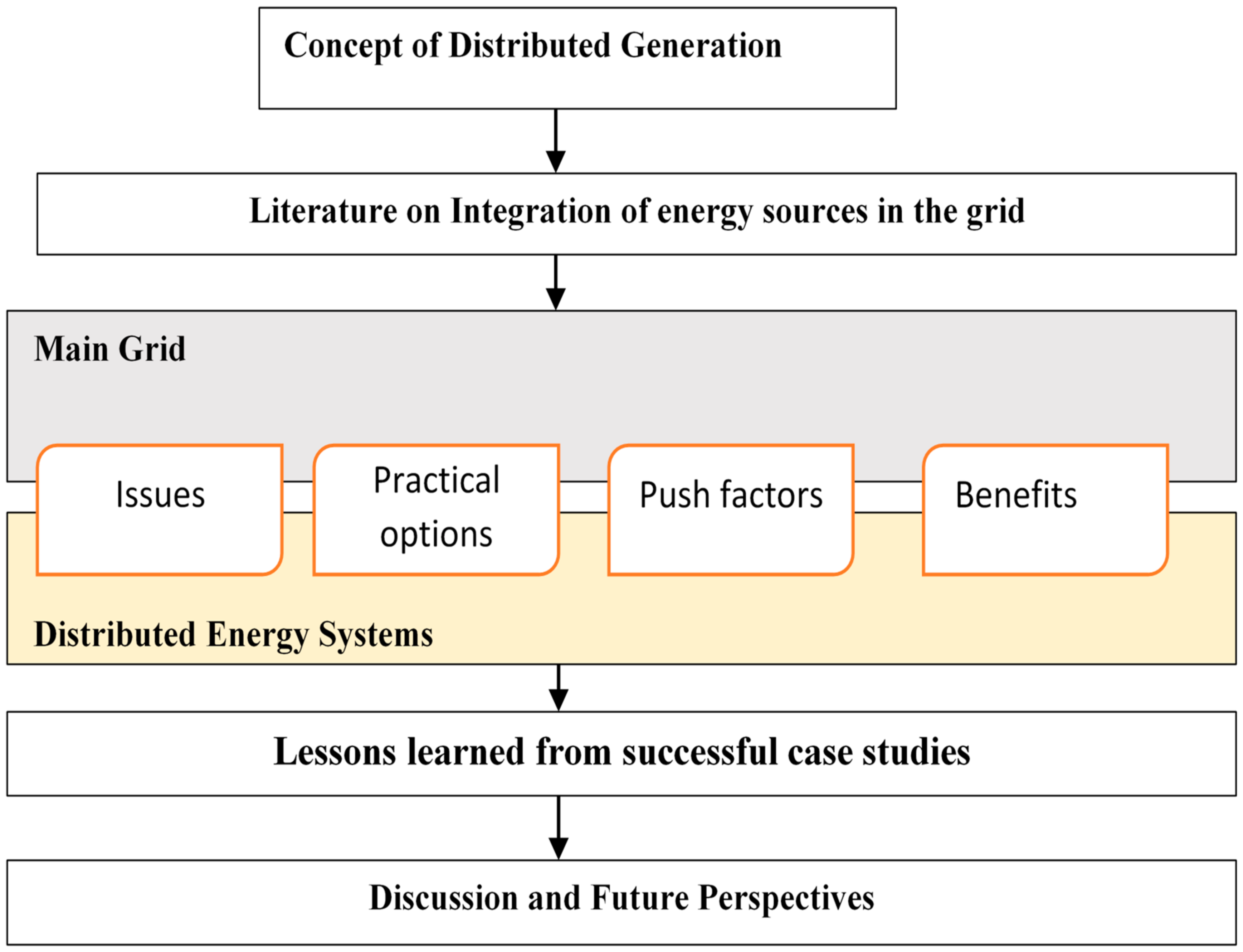

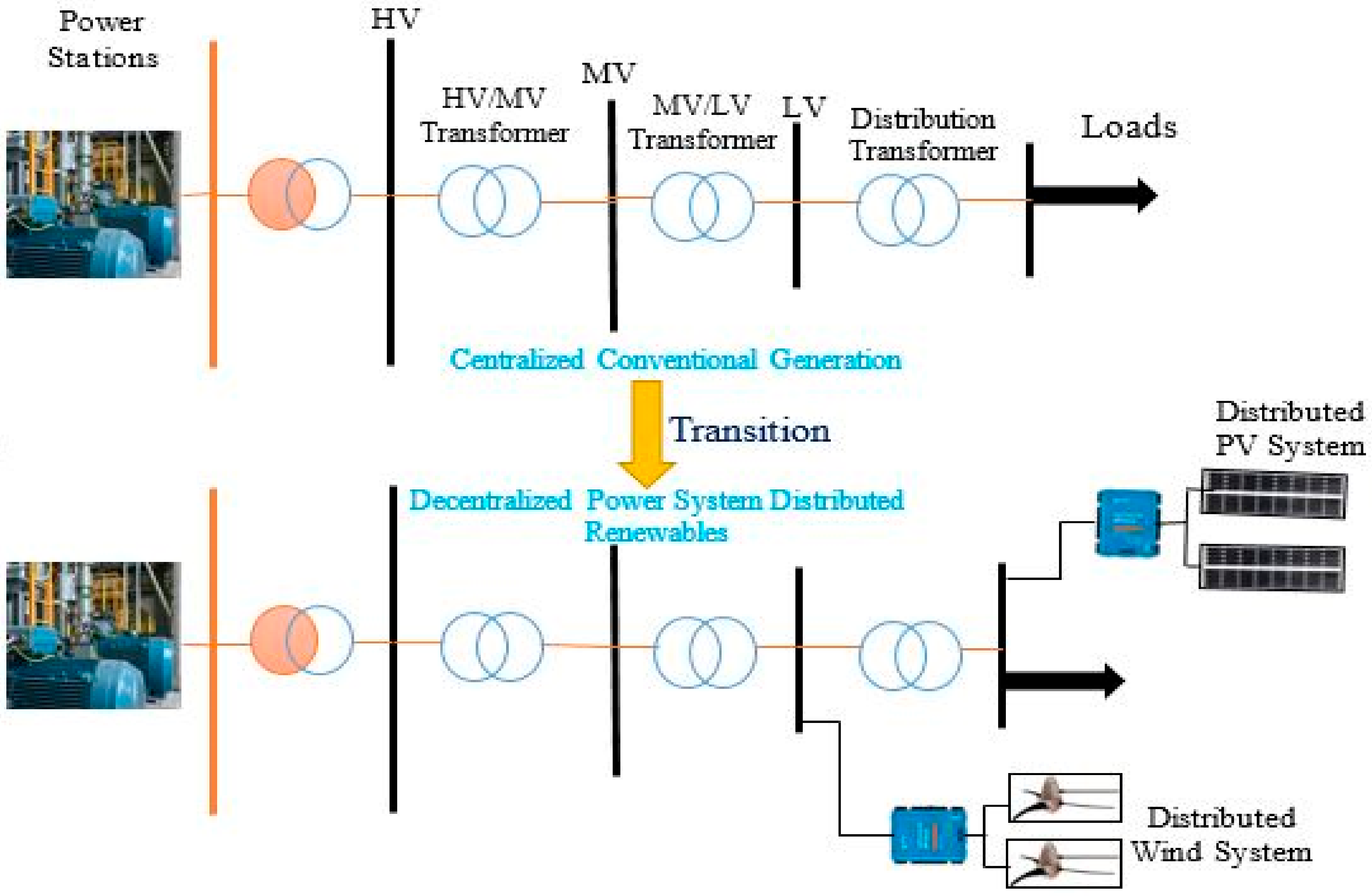
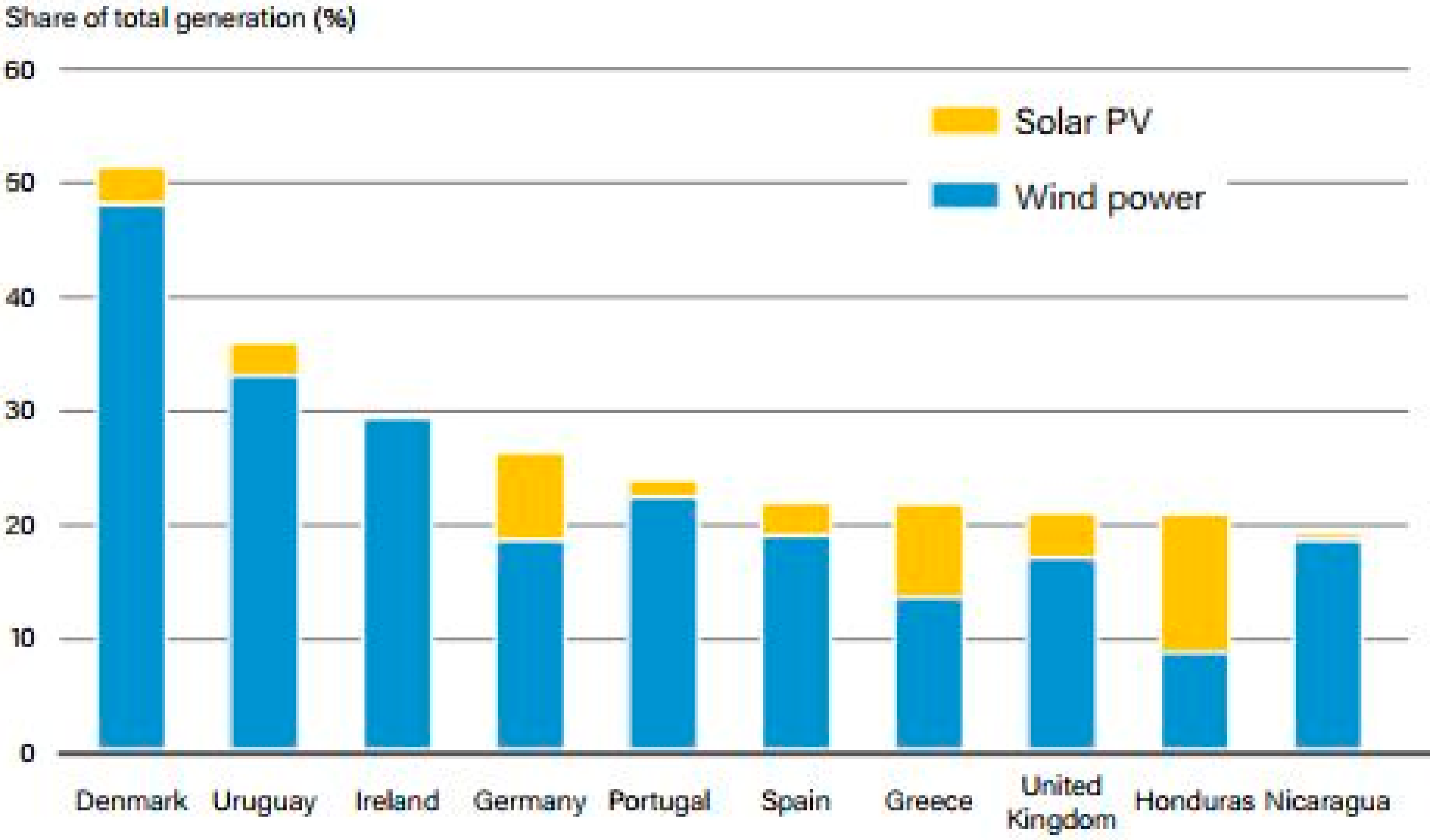



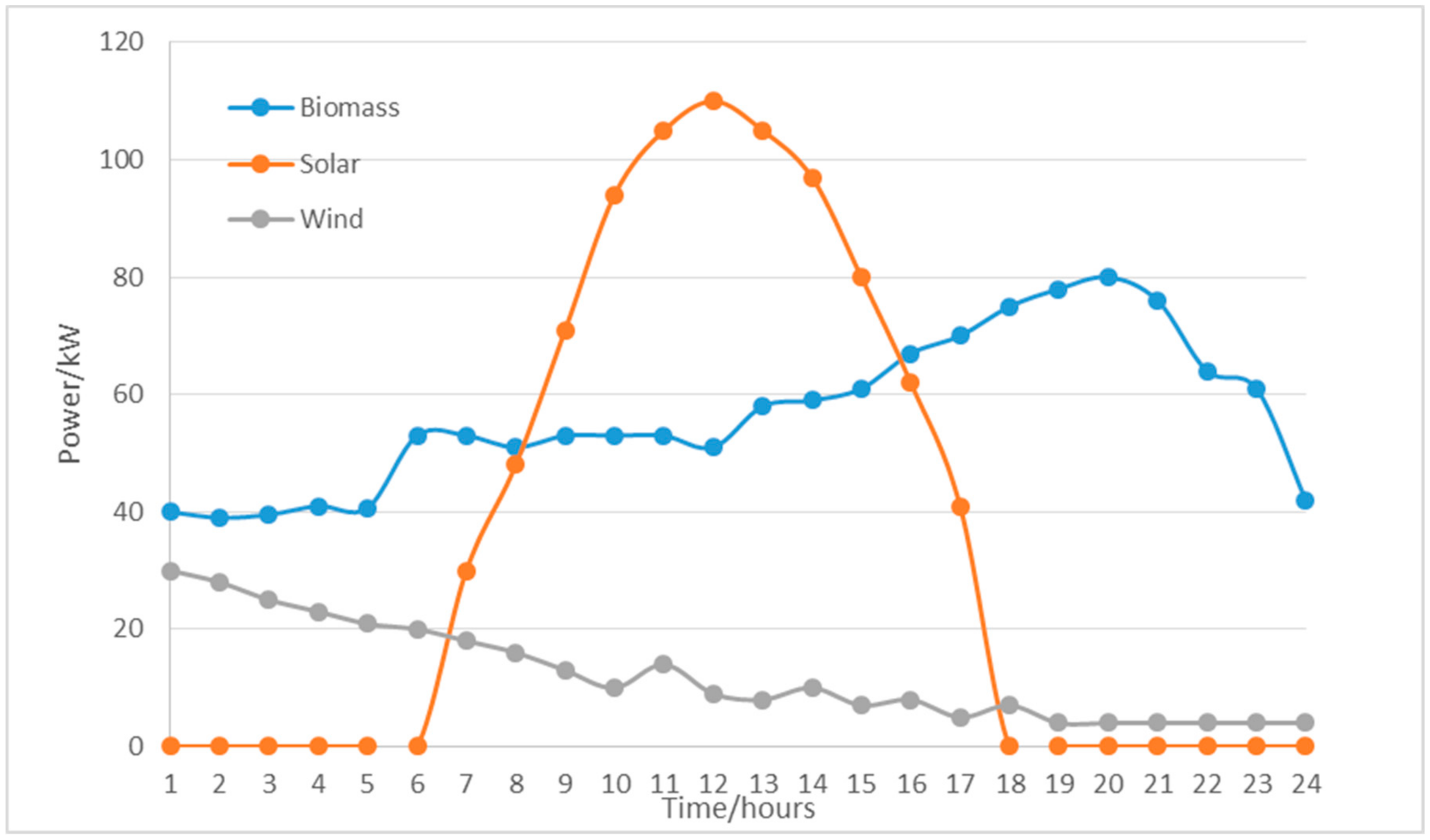
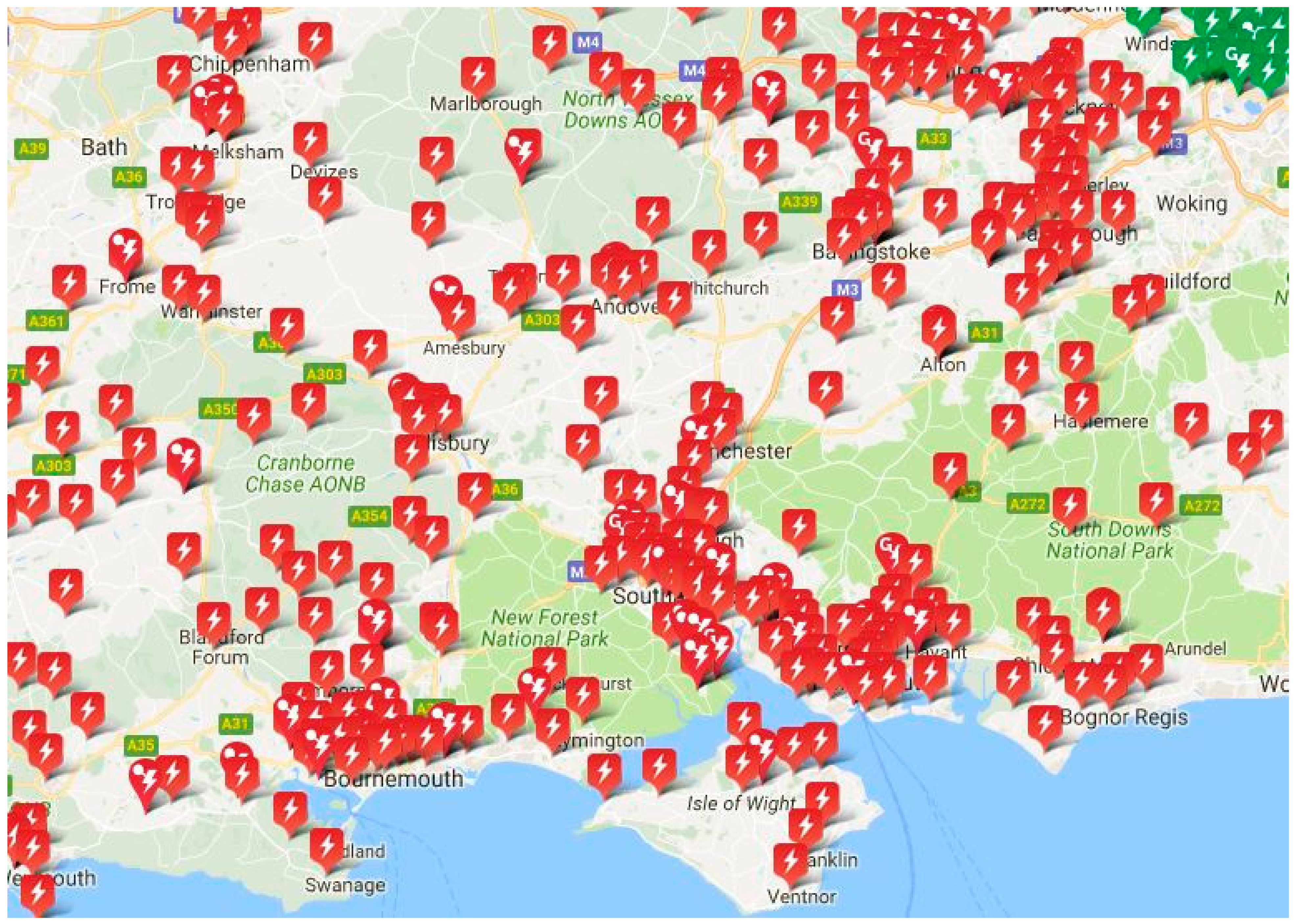
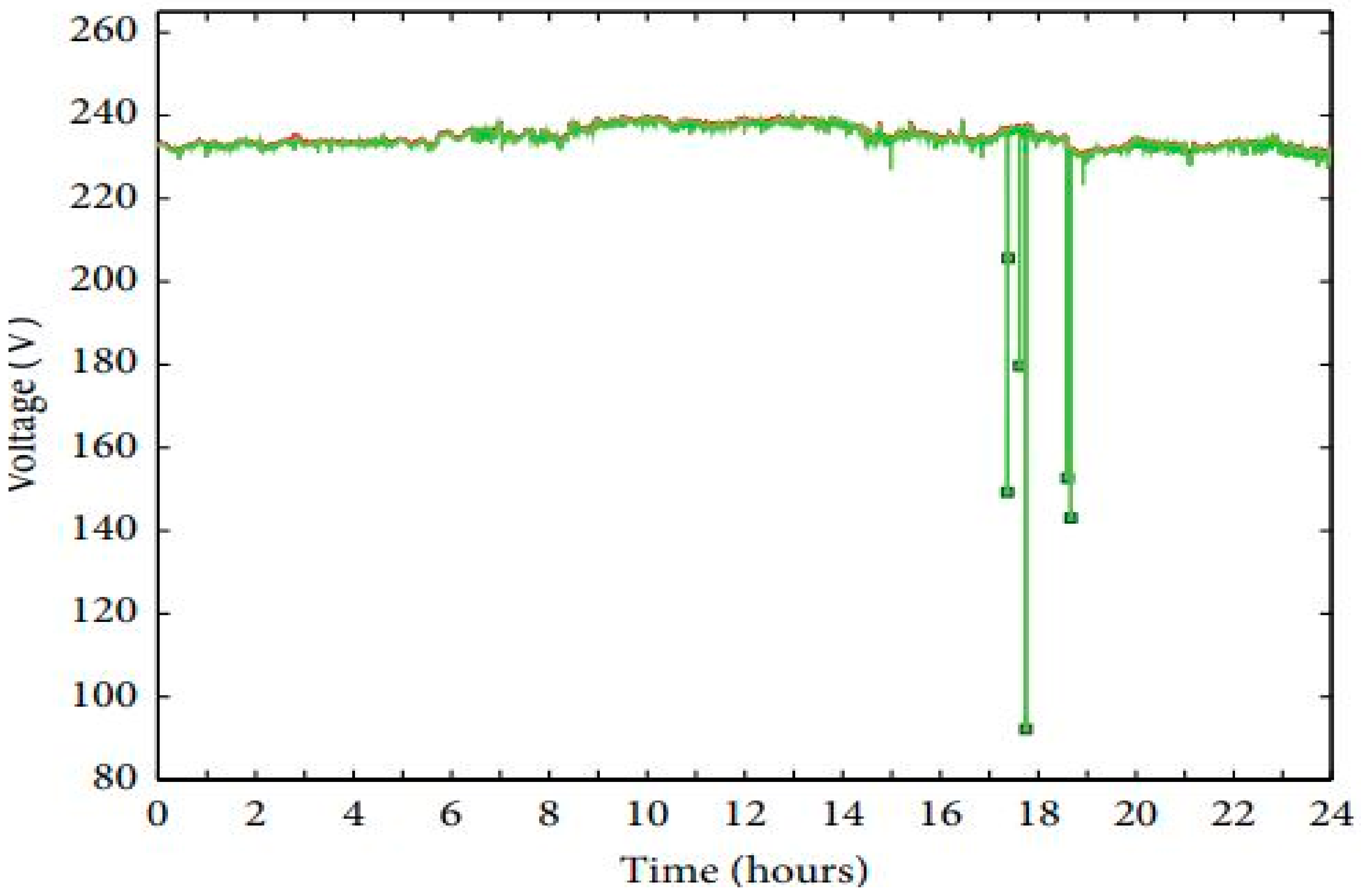


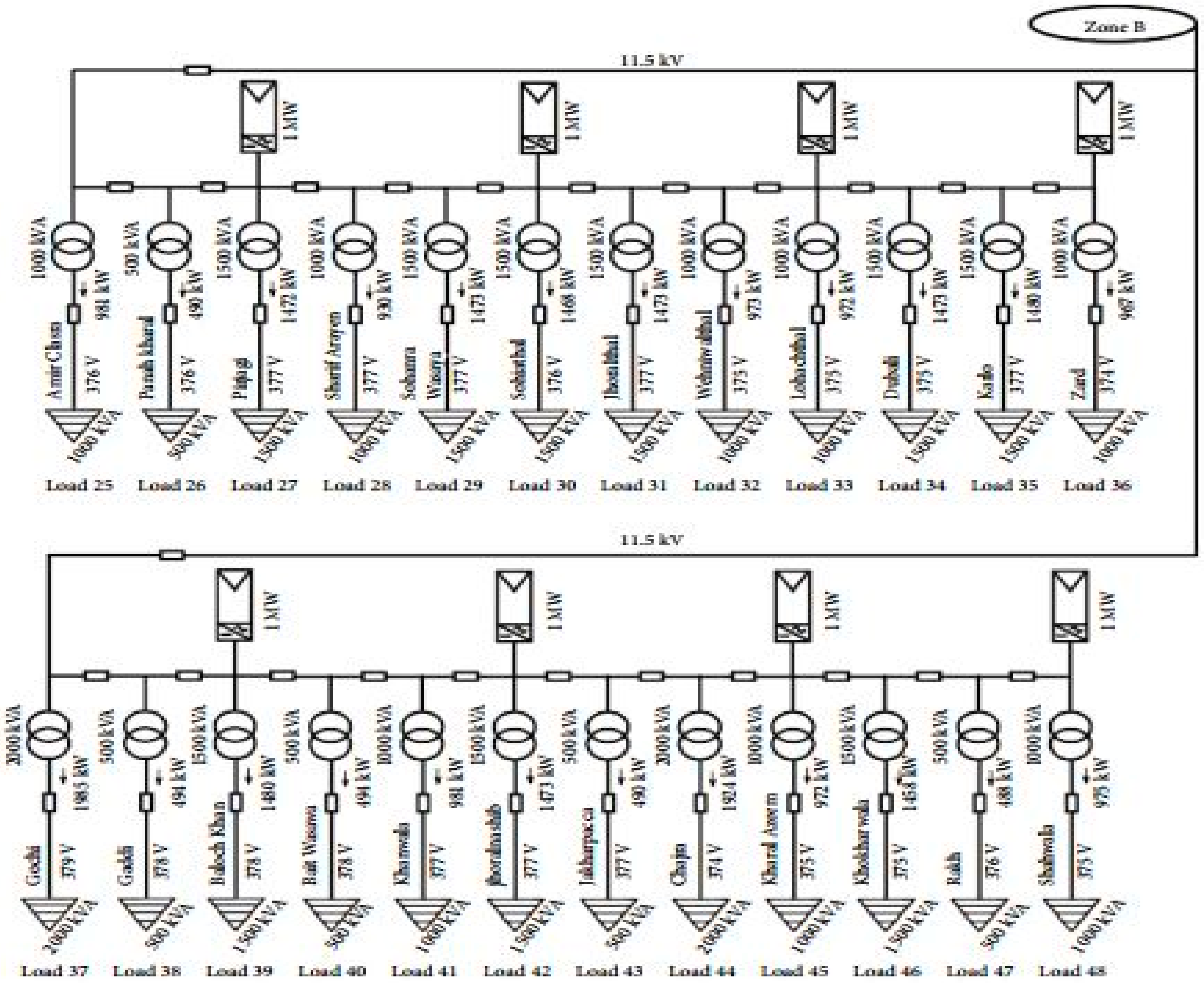
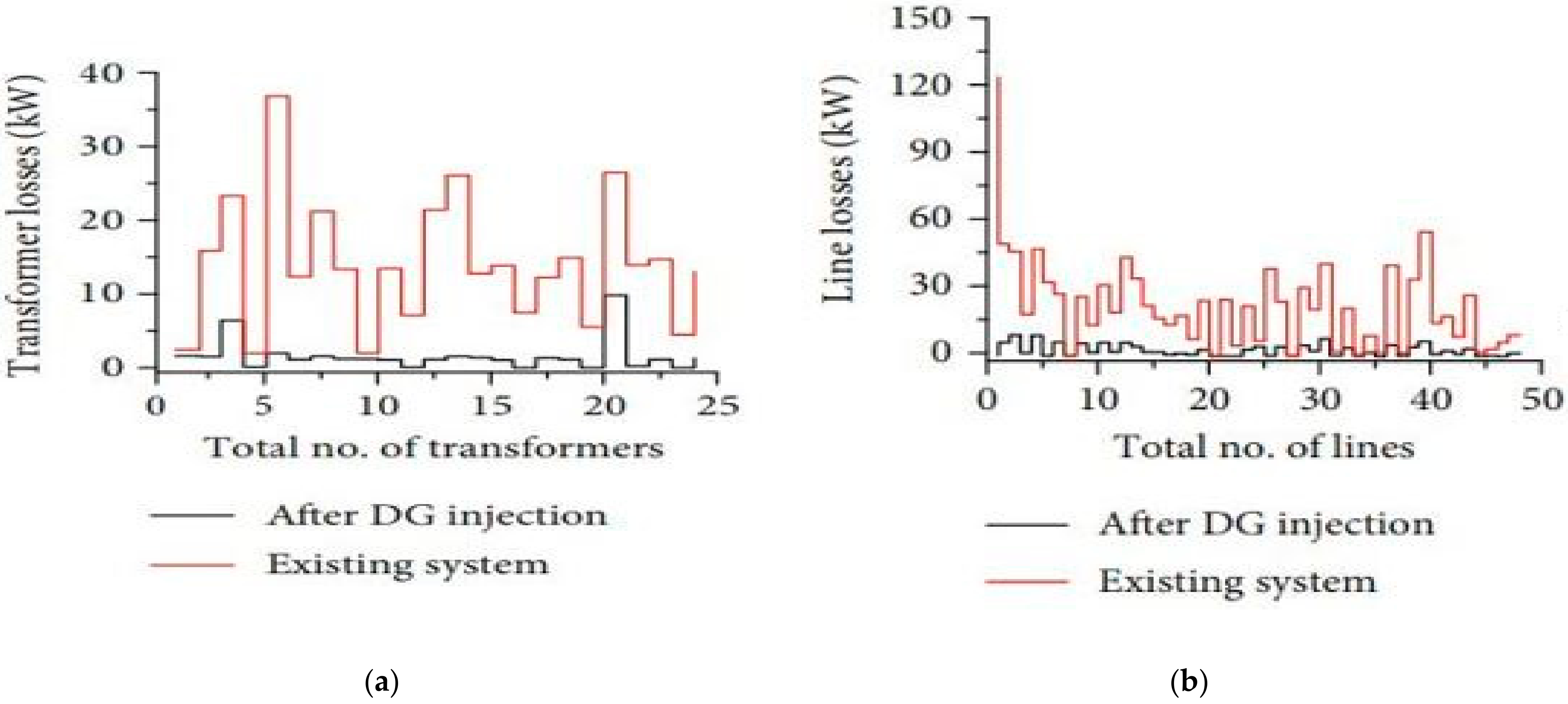


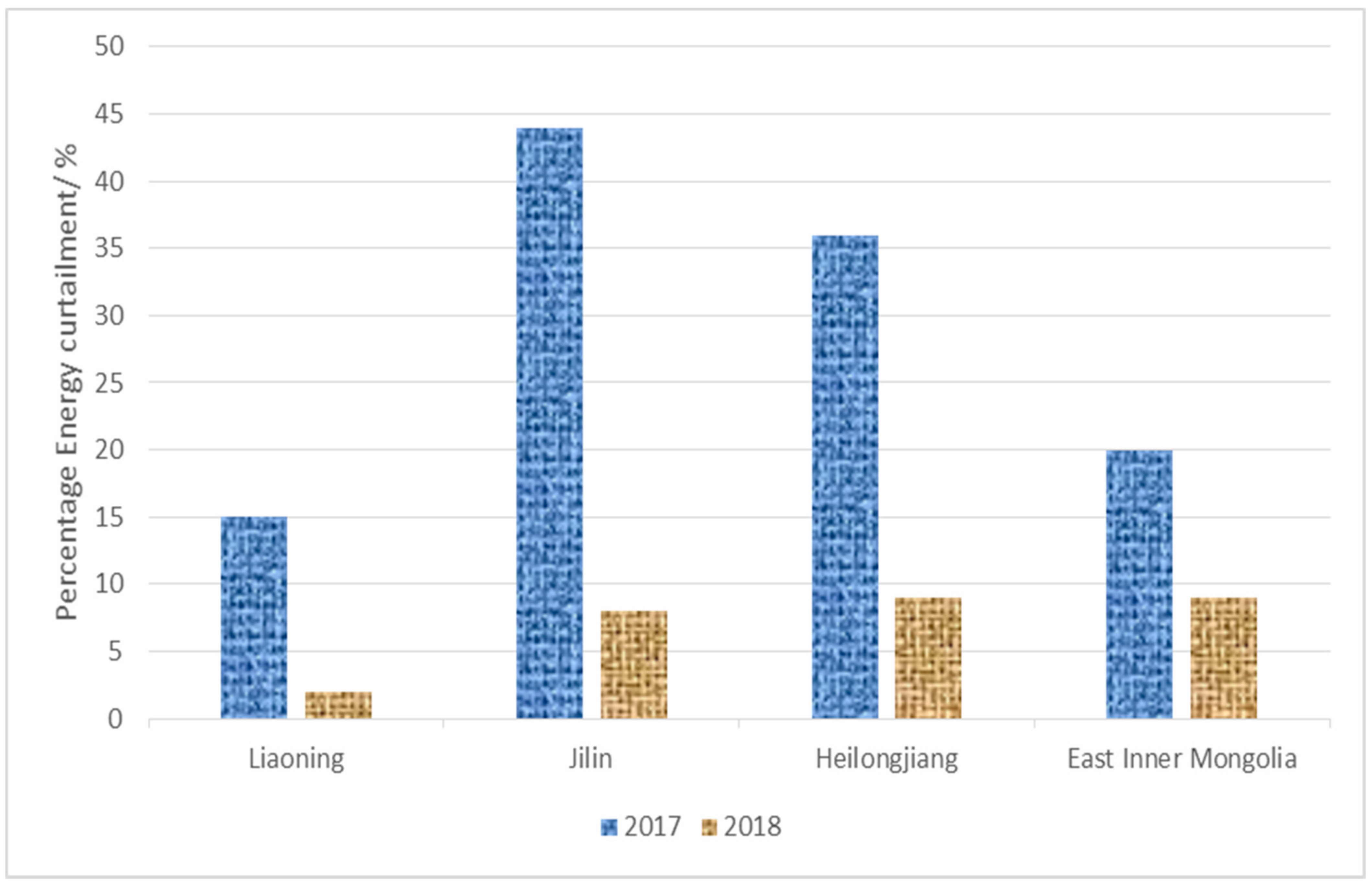
| Country/Institution | Capacity of DG | Location of DG | Mode of Operation |
|---|---|---|---|
| Sweden | ≤1500 kW | - | - |
| New Zealand | <5 MW | - | - |
| Australian Energy Market Operator | ≤30 MW | - | - |
| International Council on Large Electricity Systems | <100 MW | Most often coupled to the distribution network | Not managed/dispatched centrally |
| Bulgarian Energy Holding Company | <10 MW | Connected to the distribution network | Not managed centrally |
| Electric Power Research Institute | ≤50 MW | Most often installed near load centers or distribution and medium-voltage (MV) substations | - |
| Gas Research Institute | 25 kW ≤ X ≤ 25 MW | - | - |
| England and Wales Electricity Markets | <100 MW | - | Not dispatched at a central point |
| Estonian Power Markets | <50 MW | Connected to the distribution network | - |
| Institute of Electrical and Electronics Engineering | ≤10 MW | Connected at any point within the power grid | - |
Publisher’s Note: MDPI stays neutral with regard to jurisdictional claims in published maps and institutional affiliations. |
© 2021 by the authors. Licensee MDPI, Basel, Switzerland. This article is an open access article distributed under the terms and conditions of the Creative Commons Attribution (CC BY) license (https://creativecommons.org/licenses/by/4.0/).
Share and Cite
Iweh, C.D.; Gyamfi, S.; Tanyi, E.; Effah-Donyina, E. Distributed Generation and Renewable Energy Integration into the Grid: Prerequisites, Push Factors, Practical Options, Issues and Merits. Energies 2021, 14, 5375. https://doi.org/10.3390/en14175375
Iweh CD, Gyamfi S, Tanyi E, Effah-Donyina E. Distributed Generation and Renewable Energy Integration into the Grid: Prerequisites, Push Factors, Practical Options, Issues and Merits. Energies. 2021; 14(17):5375. https://doi.org/10.3390/en14175375
Chicago/Turabian StyleIweh, Chu Donatus, Samuel Gyamfi, Emmanuel Tanyi, and Eric Effah-Donyina. 2021. "Distributed Generation and Renewable Energy Integration into the Grid: Prerequisites, Push Factors, Practical Options, Issues and Merits" Energies 14, no. 17: 5375. https://doi.org/10.3390/en14175375
APA StyleIweh, C. D., Gyamfi, S., Tanyi, E., & Effah-Donyina, E. (2021). Distributed Generation and Renewable Energy Integration into the Grid: Prerequisites, Push Factors, Practical Options, Issues and Merits. Energies, 14(17), 5375. https://doi.org/10.3390/en14175375







